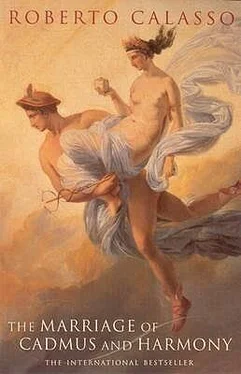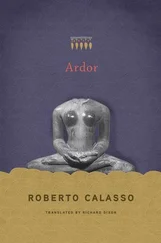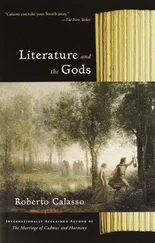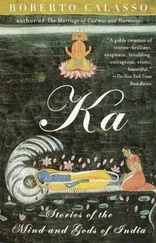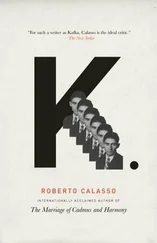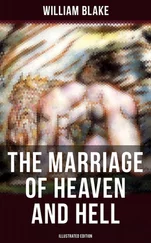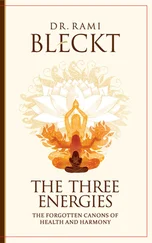Roberto Calasso - The Marriage of Cadmus and Harmony
Здесь есть возможность читать онлайн «Roberto Calasso - The Marriage of Cadmus and Harmony» весь текст электронной книги совершенно бесплатно (целиком полную версию без сокращений). В некоторых случаях можно слушать аудио, скачать через торрент в формате fb2 и присутствует краткое содержание. Год выпуска: 1993, Издательство: Alfred A. Knopf Inc, Жанр: Современная проза, на английском языке. Описание произведения, (предисловие) а так же отзывы посетителей доступны на портале библиотеки ЛибКат.
- Название:The Marriage of Cadmus and Harmony
- Автор:
- Издательство:Alfred A. Knopf Inc
- Жанр:
- Год:1993
- ISBN:нет данных
- Рейтинг книги:3 / 5. Голосов: 1
-
Избранное:Добавить в избранное
- Отзывы:
-
Ваша оценка:
- 60
- 1
- 2
- 3
- 4
- 5
The Marriage of Cadmus and Harmony: краткое содержание, описание и аннотация
Предлагаем к чтению аннотацию, описание, краткое содержание или предисловие (зависит от того, что написал сам автор книги «The Marriage of Cadmus and Harmony»). Если вы не нашли необходимую информацию о книге — напишите в комментариях, мы постараемся отыскать её.
The Marriage of Cadmus and Harmony — читать онлайн бесплатно полную книгу (весь текст) целиком
Ниже представлен текст книги, разбитый по страницам. Система сохранения места последней прочитанной страницы, позволяет с удобством читать онлайн бесплатно книгу «The Marriage of Cadmus and Harmony», без необходимости каждый раз заново искать на чём Вы остановились. Поставьте закладку, и сможете в любой момент перейти на страницу, на которой закончили чтение.
Интервал:
Закладка:
Coronis was pregnant by Apollo when she found herself attracted to a stranger. He came from Arcadia, and his name was Ischys. A white crow watched over her. Apollo had told the bird to guard the woman he loved, “so that no one might violate her purity.” The crow saw Coronis give herself to Ischys. So off it flew to Delphi and its master to tell the tale. It said it had discovered Coronis’s “secret doings.” In his fury, Apollo threw down his plectrum. His laurel crown fell in the dust. Looking at the crow, his eyes were full of hatred, and the creature’s feathers turned black as pitch. Then Apollo asked his sister Artemis to go and kill Coronis, in Lacereia. Artemis’s arrow pierced the faithless woman’s breast. Along with her, the goddess killed many other women by the rugged shores of Lake Boebeis. Before dying, Coronis whispered to the god that he had killed his own son too. At which Apollo tried to save her. In vain. His medical skills were not up to it. But when the woman’s sweet-smelling body was stretched on a pyre high as a wall, the flames parted before the god’s grasping hand, and from the dead mother’s belly, safe and sound, he pulled out Asclepius, the healer.
Ariadne, Coronis: two stories that call to each other, that answer each other. Not only was the killer the same in both cases — Artemis — but perhaps the mortal seducer was likewise the same — Theseus. Ischys is a shadowy figure, of whom we know nothing apart from his name. But of Theseus we know a great deal: we know that in one version he left Ariadne the moment “he fell desperately in love with Aigle, daughter of Panopeus.” So wrote Hesiod; but Pisistratus chose to delete this very line. Why? Did it reveal too much about the hero? A marble stele found in Epidaurus and signed by Isyllus, explains that Aigle (or Aegla) “was so beautiful that people would also call her Coronis,” and that she had a child called Asclepius. Aigle means “splendor,” as Ariadne-Aridela means “the resplendent one.” Coronis (crown) suggests a beauty that goes beyond diffuse brilliance, involves the etching of a form. But who was “Aigle, daughter of Panopeus”? Her father was the king of a small Phocian town with the same name, Panopeus: “Panopeus with its lovely open space for dancing,” says Homer. And in that square danced the Thyiades, initiates of Dionysus. It was one of the places they stopped in the long procession that took them from Athens to Delphi to “enact secret rites for Dionysus.” And already we are reminded of the open space where Ariadne danced out the labyrinth. What’s more, Pausanias explains that the inhabitants of Panopeus “are not Phocians; originally they were Phlegyans.” And already we are reminded that Coronis was the daughter of Phlegyas, from Thessaly, a hero who took the same name as his people. It was with those people that Phlegyas migrated to Phocis, where he reigned as king.
Coronis, Aigle: daughters of a king of Phocis, living near an open square where the initiates of Dionysus danced, along the road that would take them to the temple of Apollo. There is a twinning between Coronis and Aigle, just as there is a twinning between Coronis-Aigle and Ariadne, and both point us in the direction of a more obscure parallel between these women’s divine lovers: Dionysus and Apollo. Wasn’t Coronis the name of one of the Nymphs who brought up Dionysus in Naxos? And, checking through Dionysus’s other nurses, we come across, yes, another by the name of Aigle. And wasn’t Coronis also the name of one of the girls on the ship Theseus came back from Crete on? Kor  nē means “the curved beak of the crow,” but it also means “a garland, a crown.” And wasn’t Ariadne’s story a story of crowns? Kor
nē means “the curved beak of the crow,” but it also means “a garland, a crown.” And wasn’t Ariadne’s story a story of crowns? Kor  nē also means “the stern of a ship” and “the high point of a feast.” Korōnís means “the wavy flourish that used to mark the end of a book, a seal of completion.” On an Athenian jar we see Theseus carrying off a girl called Corone, while two of his other women, Helen and the Amazon Antiope, try in vain to stop him. Corone is being lifted up in the air, tightly held in the circle of the hero’s arms, yet still three fingers of her left hand find time to toy, delicately, with the curls of Theseus’s little ponytail. Casting a sharp glance behind, Peirithous protects the abductor’s back. “I saw, let’s run,” the anonymous artist’s hand has written beside the scene. The style is unmistakably that of Euthymides.
nē also means “the stern of a ship” and “the high point of a feast.” Korōnís means “the wavy flourish that used to mark the end of a book, a seal of completion.” On an Athenian jar we see Theseus carrying off a girl called Corone, while two of his other women, Helen and the Amazon Antiope, try in vain to stop him. Corone is being lifted up in the air, tightly held in the circle of the hero’s arms, yet still three fingers of her left hand find time to toy, delicately, with the curls of Theseus’s little ponytail. Casting a sharp glance behind, Peirithous protects the abductor’s back. “I saw, let’s run,” the anonymous artist’s hand has written beside the scene. The style is unmistakably that of Euthymides.
Ariadne and Coronis each preferred a foreign man to a god. For them the Stranger is “strength,” which is what the name Ischys means. And Theseus is the strong man par excellence. Of all the women to whom the gods made love, Coronis is the most brazenly irreverent. Already pregnant by Apollo’s “pure seed,” elegant in her tunics as Pindar describes her, she nevertheless felt “that passion for things far away” and went off to bed with the stranger who came from Arcadia. Pindar comments proverbially: “The craziest type of people are those who scorn what they have around them and look elsewhere / vainly searching for what cannot exist.” In Coronis’s case, what she had around her was a god, a god whose child, Asclepius, she was already bearing. It is as if, out of sheer caprice, the fullness of the Greek heaven were fractured here. The stranger from Arcadia was even more of a stranger than the god, and hence more attractive. The bright enamel of divine apparition is scarred by sudden cracks. But this allows it to breathe with the naturalness of literature, which rejects the coercion of the sacred text.
All that was left of Coronis was a heap of ashes. But years later Asclepius too would be reduced to ashes. He had dared to bring a dead man back to life, so Zeus struck him with a thunderbolt. And, just that once, Apollo cried, “wept countless tears as he approached his sacred people, the Hyperboreans.” The tears were drops of amber, and they rolled down into the Eridanus, that river at once earthly and celestial where Phaethon had fallen. All around, the stench of his corpse lingered on. And tall black poplars rustled to mourn his passing. Those poplars were the daughters of the sun.
The destiny of death by burning runs through the stories of Apollo and Dionysus like a scar. Semele is burned to death, and she is Dionysus’s mother; Coronis and Asclepius are reduced to ashes, and they are Apollo’s lover and son. The divine fire devours those venturing outside the human sphere, whether they be betraying a god, bringing a man back to life, or seeing a god bereft of the cloaking veil of epiphany. Beyond the limit laid down for what is acceptable, burns the fire. Apollo and Dionysus are often to be found along the edges of that borderline, on the divine side and the human; they provoke that back-and-forth in men, that desire to go beyond oneself, which we seem to cling to even more than to our humanity, even more than to life itself. And sometimes this dangerous game rebounds on the two gods who play it. Apollo hid his tears among the Hyperboreans while driving his swan-drawn chariot through the air. Likewise silhouetted against the sky, the enchanter Abaris, emissary of Apollo, would one day arrive in Greece from the North. Riding the immense arrow of ecstasy.
The lives of Theseus and Heracles were intertwined from beginning to end. On seeing Heracles in a lionskin, the infant Theseus had thrown an ax at him. Thinking he was a lion. The gesture suggests a secret hostility later to be submerged in admiration. When he was a youth, Theseus “would dream of Heracles’ deeds by night and burn with ambition to emulate him by day.” He never tired of hearing stories about the hero, “especially from those who had seen him and been present when he had done some deed or made a speech.” Apart from anything else, the two heroes were cousins. When he was old enough, Theseus left his home in Troezen and set off on his travels. From then on, and for years and years, Theseus and Heracles would perform similar exploits, sometimes doing exactly the same thing, as if in a competition. When the two heroes ran into each other, in foreign countries, they were like mercenaries who inevitably meet where blood is flowing. And if one day Heracles went down into the underworld to free Theseus, you would say it was no more than his duty as an old comrade in arms. Yet the distance between the two is immense. Their postures might seem similar, but in reality they were quite opposite, the way some archaic koûroi might seem similar to archaic Egyptian statues of the same period, while in fact a crucial divergence in internal time sets them apart: the Egyptian statues looked back to an irrecoverable past, which their rigidity strived hopelessly to regain; the Greek figures expressed tension the very moment before it relaxes, as if wishing to hold at bay for one last time the Alexandrian suppleness that was about to overwhelm them.
Читать дальшеИнтервал:
Закладка:
Похожие книги на «The Marriage of Cadmus and Harmony»
Представляем Вашему вниманию похожие книги на «The Marriage of Cadmus and Harmony» списком для выбора. Мы отобрали схожую по названию и смыслу литературу в надежде предоставить читателям больше вариантов отыскать новые, интересные, ещё непрочитанные произведения.
Обсуждение, отзывы о книге «The Marriage of Cadmus and Harmony» и просто собственные мнения читателей. Оставьте ваши комментарии, напишите, что Вы думаете о произведении, его смысле или главных героях. Укажите что конкретно понравилось, а что нет, и почему Вы так считаете.
